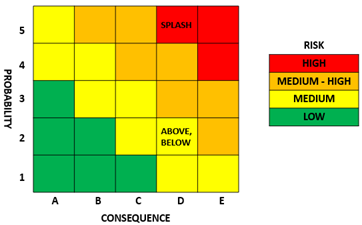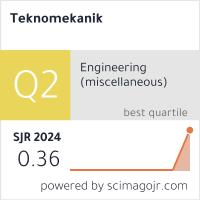Quantitative Risk-Based Inspection on Gas Riser Pipelines at Offshore Facilities
DOI:
https://doi.org/10.24036/teknomekanik.v4i2.11172Keywords:
Quantitative, Risk-Based Inspection, Gas Pipeline, Offshore, RiserAbstract
Numerous pipeline failures have occurred due to the drastic increase in oil and gas product distribution pipelines over the last three decades. Corrosion is a significant factor in the failure of offshore gas pipelines. It is necessary to maintain the integrity of the offshore transmission system, one of which is the riser, for the product to be adequately distributed. The purpose of this study is to ensure the riser's reliability by conducting a risk assessment of the probability and consequences of equipment failure, mitigating the impact of failure risk, and developing a more optimal inspection plan. The API 5L Grade X60 gas riser pipe is the subject of this study. The quantitative Risk-Based Inspection (RBI) technique was used in 2016 following the API 581 standard. This quantitative approach is founded on a numerical value model constructed using validated operational data and inspection results. The risk assessment indicates that the gas riser pipelines will have a high-risk level (5D) for the splash zone segment and a medium-risk level (2D) for the above-and below-water segments. The recommended inspection plan for the gas riser pipeline is one year after the risk-based inspection assessment.
Downloads
References
G. Pluvinage, “General Approaches of Pipeline Defect Assessment,” Safety, Reliab. Risks Assoc. with Water, Oil Gas Pipelines, pp. 1–22, Dec. 2007, doi: 10.1007/978-1-4020-6526-2_1.
W. Yu et al., “A novel methodology to update the reliability of the corroding natural gas pipeline by introducing the effects of failure data and corrective maintenance,” Int. J. Press. Vessel. Pip., vol. 169, pp. 48–56, Jan. 2019, doi: 10.1016/J.IJPVP.2018.11.001.
M. Xie and Z. Tian, “A review on pipeline integrity management utilizing in-line inspection data,” Eng. Fail. Anal., vol. 92, pp. 222–239, Oct. 2018, doi: 10.1016/J.ENGFAILANAL.2018.05.010.
US DOT Pipeline and Hazardous Materials Safety Administration, “PHMSA Pipeline Incidents: Multi-Year Averages (2001-2020),” Oct. 2021. Accessed: Oct. 12, 2021. [Online]. Available: https://portal.phmsa.dot.gov/analytics/saw.dll?Portalpages&PortalPath=%2Fshared%2FPDM Public Website%2F_portal%2FSC Incident Trend&Page=Significant.
M. J. Baker, “Pipeline Corrosion Final Report,” Nov. 2008. Accessed: Oct. 12, 2021. [Online]. Available: https://www.phmsa.dot.gov/sites/phmsa.dot.gov/files/docs/technical-resources/pipeline/gas-transmission-integrity-management/65341/finalreportpipelinecorrosion.pdf.
Y. Bai and Q. Bai, Subsea Pipelines and Risers (Ocean Engineering). 2005.
H. Priladi, J. W. Soedarsono, D. Nurprawito, and F. Perdana, “Risk Assessment on Riser at Offshore Facilities,” in International Engineering Students Conference (IESC) 2021, 2021, pp. 64 (1–5).
H. Hameed, Y. Bai, and L. Ali, “A risk-based inspection planning methodology for integrity management of subsea oil and gas pipelines,” Ships Offshore Struct., vol. 0, no. 0, pp. 1–13, 2020, doi: 10.1080/17445302.2020.1747751.
J. S. Song, V. Lok, K. B. Yoon, Y. W. Ma, and B. O. Kong, “Quantitative risk-based inspection approach for high-energy piping using a probability distribution function and modification factor,” Int. J. Press. Vessel. Pip., vol. 189, p. 104281, 2021, doi: 10.1016/j.ijpvp.2020.104281.
Mediansyah, G. D. Haryadi, R. Ismail, and S. J. Kim, “Risk Analysis of Central Java Gas Transmission Pipeline by Risk-Based Inspection Method,” IOP Conf. Ser. Mater. Sci. Eng., vol. 202, no. 1, 2017, doi: 10.1088/1757-899X/202/1/012094.
A. N. Sommeng et al., “Sensitivity analysis of gas distribution pipeline risk assessment methodology in Indonesia,” AIP Conf. Proc., vol. 2230, no. May, 2020, doi: 10.1063/5.0002612.
B. Sasikirono, S. J. Kim, G. D. Haryadi, and A. Huda, “Risk Analysis using Corrosion Rate Parameter on Gas Transmission Pipeline,” IOP Conf. Ser. Mater. Sci. Eng., vol. 202, no. 1, 2017, doi: 10.1088/1757-899X/202/1/012099.
M. Eskandarzade, R. M. Chandima Ratnayake, and M. Najafi Ershadi, “Mechanization of qualitative risk based inspection analysis,” IEEE Int. Conf. Ind. Eng. Eng. Manag., vol. 2020-Decem, pp. 401–406, 2020, doi: 10.1109/IEEM45057.2020.9309754.
J. K. Seo, Y. Cui, M. H. Mohd, Y. C. Ha, B. J. Kim, and J. K. Paik, “A risk-based inspection planning method for corroded subsea pipelines,” Ocean Eng., vol. 109, pp. 539–552, Nov. 2015, doi: 10.1016/J.OCEANENG.2015.07.066.
M. O. Z. A. Lubis, A. Widodo, and G. D. Haryadi, “Risk Assessment of Gas Pipeline using Risk based Inpection and Fault Tree Analysis,” no. Eic 2018, pp. 43–47, 2020, doi: 10.5220/0009006100430047.
American Petroleum Institutes (API), Risk-Based Inspection Methodology API RP 581, Third Edit. Washington, DC 20001: API Publishing Services, 2016.
A. Rachman and R. M. C. Ratnayake, “Machine learning approach for risk-based inspection screening assessment,” Reliab. Eng. Syst. Saf., vol. 185, pp. 518–532, May 2019, doi: 10.1016/J.RESS.2019.02.008.
J. T. Reynolds, “Risk Based Inspection - Where Are We Today?,” CORROSION 2000. Mar. 26, 2000.
R. Amaya-Gómez, M. Sánchez-Silva, and F. Muñoz, “Integrity assessment of corroded pipelines using dynamic segmentation and clustering,” Process Saf. Environ. Prot., vol. 128, pp. 284–294, 2019, doi: https://doi.org/10.1016/j.psep.2019.05.049.
L. A. Malik, J. W. Soedarsono, M. S. Yudim, and R. Riastuti, “Risk based inspection of corroded gas pipelines,” Int. J. Mech. Prod. Eng. (IJMPE)-IJMPE, vol. 8, no. 10, pp. 1–4, 2020, [Online]. Available: http://ijmpe.iraj.in/paper_detail.php?paper_id=17604&name=Risk_based_Inspection_of_Corroded_Gas_Pipelines.
P. P. ONWJ, “Tata Kerja Organisasi Pedoman Perbaikan Riser,” PHEONWJ-W-TKO-0020, 2020.
The American Society of Mechanical Engineers, ASME B31G - Manual for Determining the Remaining Strength of Corroded Pipelines. New York, NY 10016-5990: The American Society of Mechanical Engineers, 2009.
American Petroleum Institutes (API), Piping Inspection Code : In-service Inspection , Rating , Repair , and Alteration of Piping Systems API 570, Fourth Edi. Washington, DC 20005: API Publishing Services, 2016.
ASME B31.4, Pipeline Transportation Systems for Liquids and Slurries. New York, NY 10016-5990: The American Society of Mechanical Engineers, 2019.
R. Singh, Corrosion Control for Offshore Structures, 1st Editio. United Kingdom, UK: Gulf Professional Publishing, 2014.

Downloads
Published
Issue
Section
License
Copyright (c) 2021 Mhd. Ibkar Yusran Asfar, Johny Wahyuadi Soedarsono, Arie Wijaya, Dony Soelistiyono, Romal Ramadhan (Author)

This work is licensed under a Creative Commons Attribution 4.0 International License.




